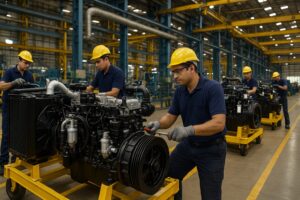Overview and Business Models
Kirloskar Oil Engines Ltd (KOEL), part of the Kirloskar Group, primarily focuses on manufacturing internal combustion engines, diesel generator sets, and related agricultural and industrial equipment. The company’s strength lies in its wide product range catering to agri, industrial, power generation, and construction sectors. KOEL is strongly rooted in rural India, with a well-established distribution network and brand loyalty, especially in the farm and standby power markets.
Cummins India Ltd, the Indian arm of US-based Cummins Inc., operates in engine manufacturing, power generation, and distribution. Its business model is technology-driven, leveraging its parent company’s global R&D and emissions-compliant engine tech. It supplies engines across automotive, industrial, rail, construction, and marine sectors. Cummins also earns significant revenues from after-sales services and parts—highlighting its annuity-based income streams.
Greaves Cotton Ltd, traditionally known for its small diesel engines used in three-wheelers, has evolved into a diversified engineering company. It manufactures engines for industrial and automotive use, and more recently has ventured into clean energy solutions and electric mobility via Ampere Electric. The company now presents itself as a powertrain and e-mobility solutions provider, pivoting toward future-ready technologies.
Ashok Leyland’s Engines Division primarily focuses on diesel engines for commercial vehicles, industrial applications, and gensets. While Ashok Leyland is known for its heavy vehicle manufacturing, its power solutions business—marketed under ‘Leypower’—caters to a range of stationary engine applications. Though less standalone than others, the division contributes to Leyland’s vertical integration and aftermarket ecosystem.
Market Segments and Customers
KOEL serves four major sectors: power generation, industrial engines, agricultural engines, and large engines for defense and marine applications. It has a strong presence in decentralized power and irrigation markets, with a deep rural reach. Its customer base includes farmers, small industries, construction firms, and government agencies.
Cummins India serves OEMs, commercial fleets, infrastructure firms, and institutional customers. With a significant chunk of revenue coming from exports, it caters to domestic and international engine markets. The firm has longstanding relationships with OEMs like Tata Motors and is a supplier of choice in low-emission diesel and natural gas engines.
Greaves Cotton traditionally catered to automotive OEMs in the three-wheeler segment (Bajaj Auto, Piaggio) but is now diversifying into last-mile electric mobility consumers and industrial clients through gensets and clean tech engines. The customer base is shifting from OEM-focused to end-consumer, particularly in the electric mobility space.
Ashok Leyland’s engine division primarily serves B2B customers—construction firms, industrial clients, infrastructure projects, and power backup consumers. The firm also taps into export markets for gensets and industrial engines. Its captive use for Leyland’s own CVs ensures internal demand continuity.
Technology, R&D and Innovation
Cummins leads in R&D and emissions technology. It was among the first to introduce BS-VI compliant engines in India and is actively developing hydrogen and hybrid engine platforms. With a global technology backbone and deep engineering talent in India (via the Cummins Technical Center), it commands a tech premium.
KOEL has steadily innovated in improving fuel efficiency and service intervals, particularly for its genset and agri engines. However, its innovation is more incremental and geared toward reliability rather than cutting-edge disruption. It is working on alternative fuel engines, including biodiesel and CNG variants.
Greaves Cotton is investing heavily in e-mobility through its Ampere brand and is also developing clean fuel engines for hybrid applications. It recently launched high-speed BS-VI diesel engines and fuel-agnostic solutions to remain relevant as ICE demand shifts.
Ashok Leyland’s engine innovations are tied closely with vehicle technology. Its iEGR and Modular Powertrain platforms allow efficient performance with easier servicing. However, its engines are primarily designed for commercial use-cases rather than standalone industrial dominance.
Financials and Market Capitalization (as of August 2025)
-
Cummins India commands the highest market cap in this group (~₹90,000 crore), benefiting from strong export revenue, stable margins, and robust ROCE (20%+). FY25 revenue stood at ~₹9,500 crore with net profit crossing ₹1,200 crore.
-
Ashok Leyland, although a CV manufacturer, attributes ~8–10% of its revenue to the engines and genset business. Its market cap is ~₹60,000 crore with total revenues over ₹45,000 crore, though engine division-specific figures are not disclosed separately.
-
Kirloskar Oil Engines has a market cap of ~₹9,500 crore, with FY25 revenues of ~₹4,200 crore and healthy EBITDA margins (~13%). The company has minimal debt and strong cash flows.
-
Greaves Cotton lags in scale (~₹3,800 crore market cap), with total revenue around ₹2,100 crore (FY25), but it’s positioning itself for future growth via electric mobility and clean tech. Profitability is still recovering after high R&D and capex cycles.
Strengths and Weaknesses
-
Cummins India’s strength lies in its global tech backing, strong after-sales revenue, and diverse sector presence. However, it is exposed to export volatility and regulatory risks around emission norms.
-
Kirloskar Oil Engines enjoys brand trust in rural India and strong execution in domestic gensets, but faces growth limitations due to heavy dependence on diesel power and lack of major export exposure.
-
Greaves Cotton has agility and first-mover advantage in e-mobility, but legacy engine volumes are declining and its electric unit is still in investment mode with profitability challenges.
-
Ashok Leyland (Engines) benefits from integration with its CV business and a growing genset market, but it lacks standalone brand identity in the engine space and relies heavily on internal consumption.
Strategic Directions and Future Outlook
Cummins India is doubling down on alternative fuels, hydrogen IC engines, and hybrid systems. It aims to maintain leadership in clean diesel and become a dominant player in India’s green energy transition.
Kirloskar is expanding into CNG and biodiesel-based engines, targeting both agri and industrial applications. It is also investing in digitizing customer service and improving remote diagnostics across its engine base.
Greaves Cotton is transforming itself into an energy-tech player, betting on electric two- and three-wheelers, while de-risking from diesel engines. It aims to integrate Ampere with its core powertrain business to create a future-ready ecosystem.
Ashok Leyland is focusing on expanding its power solutions business, especially for construction and infrastructure clients. Its upcoming hydrogen-ICE partnerships and defense engine offerings may open new doors.
Investors and Ownership Structures
Cummins India is majority-owned by Cummins Inc. (USA), which brings credibility, long-term capital, and cutting-edge technology.
Kirloskar Oil Engines is part of the Kirloskar Group, with a significant promoter holding (~57%), and a long-standing investor base that values its steady returns and rural focus.
Greaves Cotton is institutionally backed, with high retail participation, and has seen rising investor interest due to its e-mobility pivot.
Ashok Leyland is part of the Hinduja Group, and its diversified business model makes it more resilient, but the engines division remains a minor (yet growing) contributor.
Conclusion
In India’s engine ecosystem, Cummins India stands tall on technological prowess, export-led revenue, and emissions leadership. Kirloskar Oil Engines is a domestic powerhouse for diesel engines and gensets with deep rural reach. Greaves Cotton is reinventing itself with electric and clean-fuel mobility ambitions, while Ashok Leyland’s engine division remains a synergistic growth lever in its broader CV strategy. Each firm reflects a different engine of growth—technology, legacy strength, innovation, or integration—making this comparison a microcosm of India’s energy and mobility transformation.




